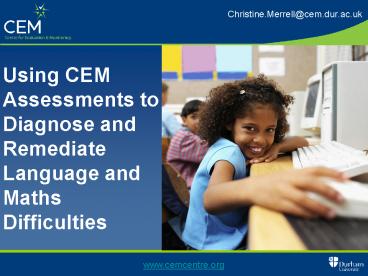Using CEM Assessments to Diagnose and Remediate Language and Maths Difficulties - PowerPoint PPT Presentation
1 / 36
Title:
Using CEM Assessments to Diagnose and Remediate Language and Maths Difficulties
Description:
Christine.Merrell_at_cem.dur.ac.uk Using CEM Assessments to Diagnose and Remediate Language and Maths Difficulties www.cemcentre.org – PowerPoint PPT presentation
Number of Views:320
Avg rating:3.0/5.0
Title: Using CEM Assessments to Diagnose and Remediate Language and Maths Difficulties
1
Using CEM Assessments to Diagnose and Remediate
Language and Maths Difficulties
- Christine.Merrell_at_cem.dur.ac.uk
www.cemcentre.org
2
- Reading
- Word Recognition, Word Decoding, Comprehension
- Spelling
- General Maths
- Number 1, Number 2, Handling Data, Measures Shape
and Space - Mental Arithmetic
- Addition, subtraction, multiplication, division
- Picture vocabulary
- Non-verbal ability
- Attitudes
3
Beginning to Read
- Children need different types of knowledge
- Global and cultural awareness
- Vocabulary and basic understanding of language
- Conventions of print
- Phonological awareness
4
Reading an Interactive Compensatory Process
Word recognition/decoding
Comprehension
5
Problems with Literacy Acquisition
- Dyslexia
- Found across the whole intelligence range
- Continuum of severity
- 3 males 1 female
6
Types of Difficulties
- Phonological deficit
- Visual memory
- Speed of processing
These can overlap
7
Maths Difficulties
- Institutional/Environmental
- Motivational
- Neuropsychological
8
Standard Feedback
Achievement
9
Standard Feedback
Developed Ability
10
Standard Feedback
Reading Modules
11
Standard Feedback
General Maths Modules
12
Standard Feedback
Developed Ability Modules
13
Standard Feedback
Attitudes
14
Scores Charts
15
Scores Charts
16
Scores Charts
17
Longitude Charts
18
Longitude Charts
19
Age Comparison Charts
Reading
20
Word recognition decoding
Holistic Approach Whole Word Identification
Direct Phonics Instruction
Useful for building large sight-vocabulary
Recognition of 100 high-frequency words Enables
reading of 50 of all text
Large demands on visual memory and no strategies
for tackling unfamiliar words
21
Word recognition decoding
- Phonics programme with whole word element
- E.g. Jolly Phonics
- Letter sounds
- Letter formation
- Blending sounds
- Identifying sounds in words
- Tricky, irregular words
22
Word recognition decoding
- Sound Linkage by Peter Hatcher
- Young children with significant and persistent
problems - Dyslexia, Speech and Language
- A Practitioners Handbook,
- Edited by Snowling and Stackhouse, 1996,
- Whurr Publishers (www.whurr.co.uk)
23
Fluency and Readability
- Word length
- Sentence length
- Viewing regions
- Use of graphics to reduce cognitive load and
maintain readers interest
24
Viewing Regions
- You are reading a sentence and deciding
- if you can skip a word
- Brain makes predictions
- Strong understanding of context helps brain to
fill in words - not directly fixated on
25
Viewing Regions
- There once lived, in a
- sequestered part
- of the county of
- Devonshire, one
- Mr Godfrey Nickleby a
- worthy gentleman, who,
- taking it into his head
- rather late in life that he
- must get married, and not
- being young enough or
- rich enough to aspire to
the hand of a lady of fortune, had wedded an
old flame out of mere attachment, who in her
turn had taken him for the same reason. Thus
two people who cannot afford to play cards for
money, sometimes sit down to a quiet game for
love.
26
Viewing Regions
- Holsten, before he died, was destined to see
atomic energy - dominating every other source of power, but for
some years - yet a vast network of difficulties in detail and
application kept - the new discovery from any effective invasion of
ordinary life. - The path from the laboratory to the workshop is
sometimes a - tortuous one electro-magnetic radiations were
known and - demonstrated for twenty years before Marconi made
them - practically available, and in the same way it was
twenty years - before induced radio-activity could be brought to
practical - utilisation.
27
Comprehension
- Good readers use
- Cognitive strategies
- Re-reading difficult parts
- Utilising background knowledge, contextual clues
and graphics - Adjusting reading speed
- Some children use these spontaneously, others
have to be taught
28
Use of graphics
Scan path for separated graphics (Holsanova et
al., 2008)
29
Use of graphics
Scan path for integrated graphics
30
Use of graphics
Scan path for radial graphics
31
Use of graphics
Scan path for serial graphics
32
Comprehension
- Knowledge of text structures
- Vocabulary
- Background knowledge
- Fluent word recognition and decoding
- Task persistence
- Ability to understand verbal communication
33
Vocabulary Knowledge
- Underline two interesting words per paragraph
- Explain why these are interesting
- Any interesting strategies to share?
34
Task persistence
- Encouragement, praise, rewards, especially
- effective for children with ADHD
Cross-age peer tutoring www.fifepeerlearning.org
35
How to help
- Instant Feedback
- Computer programs
- Peer tutoring
- Evaluate incorrect responses
- Encourage cautious children to try new strategies
- Memory aids for children with working memory
difficulties - Tackle comorbid literacy problems
36
The Number Race
- Open source software www.unicog.org
- Reinforces link between number sense
- and symbolic number representations
- Remediation strategy but also useful for
- children in early stages of learning arithmetic





























